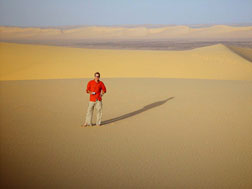NEWS RELEASES
FOR IMMEDIATE RELEASE
January 8, 2007
Discover magazine recognizes Sandia physicist Mark Boslough
 Mark
Boslough
Mark
BosloughDownload 300dpi JPEG image, “boslough-egypt.jpg,” 412K (Media are welcome to download/publish this image with related news stories.)
ALBUQUERQUE, N.M. — Discover magazine has recognized work done by Sandia National Laboratories physicist Mark Boslough as one of the “Top 100 Science Stories of 2006.”
Boslough’s Red Storm computer exercise that modeled an asteroid impact with the atmosphere over the Sahara Desert is featured in the January 2007 issue of the magazine.
Every year, Discover magazine selects 100 important and interesting science stories of the previous year to be featured in the special annual report.
Earlier this year, Boslough described in a documentary telecast on the National Geographic Channel the conditions that would have been required to create desert glass like the piece that is the central jewel in King Tutankhamen’s pectoral jewelry.
Sandia is a National Nuclear Security Administration (NNSA) laboratory.
Using Sandia’s Red Storm — an air-cooled supercomputer that is rated second fastest in the world, and developed by Sandia and Cray Inc. using off-the-shelf parts — Mark developed a simulation that suggests a 400-foot-wide stony asteroid slammed into the Earth’s atmosphere at 12 miles a second and exploded.
For 20 seconds, the resulting fireball would have been hot enough to melt quartz on the ground, creating the glass that can still be found in the desert.
“I had stumbled into the debate by accident in 1996, when I attended a conference in Bologna on the subject of the 1908 explosion of an asteroid or comet that knocked down nearly a thousand square miles of trees in Siberia,” said Boslough.
“I stayed an extra day to attend a meeting about the desert glass, where I argued that similar — but larger — atmospheric explosions could create fireballs that would be large and hot enough to fuse surface materials to glass,” he says. “Much like the first atomic explosion generated green glass at the Trinity site in 1945.”
Mark described his journey to the Libyan Desert for participation in the filming of the documentary in the Sept. 15 issue of the Lab News, “Riddle of the Desert Glass.”
Sandia is a multiprogram laboratory operated by Sandia Corporation, a Lockheed Martin company, for the U.S. Department of Energy’s National Nuclear Security Administration. Sandia has major R&D responsibilities in national security, energy and environmental technologies, and economic competitiveness.
Sandia is a multiprogram laboratory operated by Sandia Corporation, a Lockheed Martin company, for the U.S. Department of Energy’s National Nuclear Security Administration. Sandia has major R&D responsibilities in national security, energy and environmental technologies, and economic competitiveness.
Sandia media contact: Michael Padilla, mjpadil@sandia.gov, (505) 284-5325